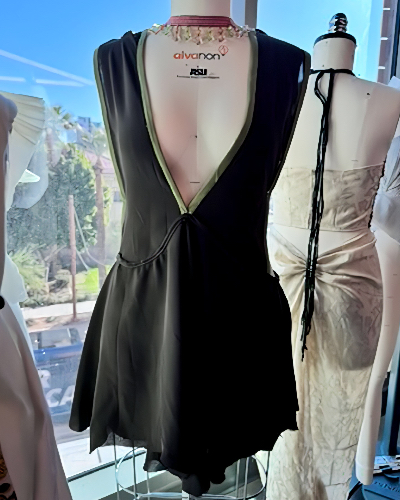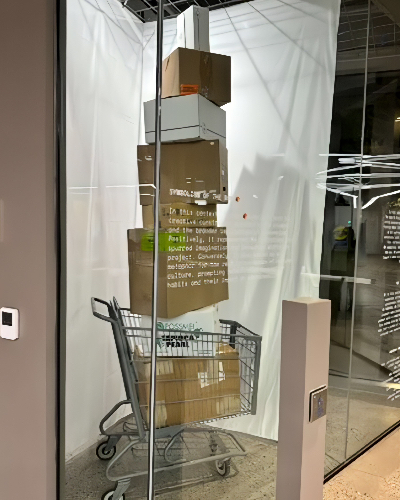BY TYLER BUTLER
In a world where overconsumption of textiles has reached unsustainable levels, the fashion industry is at a crossroads. The push for sustainable practices is no longer a trend but a necessity for the planet’s future. A groundbreaking initiative, the Beyond the Lab project, is leading the charge toward more responsible, innovative design through a unique collaboration between Arizona State University’s Fashion Institute of Design and Merchandising (ASU FIDM), Supima, Sustainable Fashion Week (SFW), and the Beyond the Lab grant by the ASU Humanities Lab. This project, anchored in sustainability, creativity, and community, is a prime example of how partnerships can create powerful change in fashion design.
The Beyond the Lab grant underwrites projects like this one, empowering academic initiatives to extend beyond traditional classroom settings and reach real-world audiences. For this project, it provided the resources to create a collaborative platform where students, faculty, industry experts, and designers could experiment with sustainable fashion principles. The project’s culminating event, the “Box Project,” emphasized the reuse of materials, challenging students to create innovative garments using only pre-existing textiles. A New Blueprint for Fashion Education, The Box Project re- examines how fashion is taught.
By incorporating sustainability into the curriculum, ASU FIDM is preparing students to address real-world challenges with innovation and purpose, leading to designs that break traditional fashion boundaries. “It’s disorienting at first when you’re used to working with new materials,” says Jessica Kosak, an instructor at ASU FIDM. “But that’s where innovation begins. We’re overproducing and over consuming textiles. It’s time to rethink and reuse what already exists.”
Jessica’s passion for waste reduction inspired students to approach sustainability as a responsibility rather than a limitation, helping them recognize the potential for beauty and functionality in repurposed designs. At the heart of the project is collaboration. ASU FIDM, led by Founding Director Dennita Sewell and Program Manager Remington Reble, crafted the curriculum to give students hands-on experience with sustainable practices. Each student was tasked with creating garments using only materials from a curated set of “boxes” filled with upcycled items and pre-existing textiles, with minimal allowances for notions like thread or zippers. The exercise forced participants to think outside the box — literally— and gave rise to inventive, thought-provoking designs that embodied the principles of sustainability.

Supima, a vital partner in the project, contributed high-quality, responsibly sourced cotton.“This collaboration with ASU FIDM and Beyond the Lab has been incredibly fulfilling,” says Marc Lewkowitz, CEO of Supima. “It’s not just about using sustainable materials; it’s about equipping the next generation of designers with tools to reimagine what ethical fashion looks like.” Supima’s support allowed students to experiment with premium sustainable fabrics, showcasing that eco-conscious choices don’t have to compromise quality. Bridgett Artise — founder of Sustainable Fashion Week, owner of HouseofBAV, and owner and designer of Born Again Vintage — brought her expertise to the collaboration, offering guest lectures and leading discussions that bridged the gap between academia and industry.
“At SFW, we believe in the power of partnerships. The motto is ‘Stronger Together,’ and this project proved exactly that,” Artise shares. Her guidance reinforced the idea that sustainability is not a solo endeavor — it thrives when people share knowledge and passion.

The partnership culminated in a stunning window display at Fusion on First in Phoenix, where the students’ creations were showcased. This display, featuring a blend of fashion and digital media, told the story of each garment’s transformation from discarded material to innovative design. Jill Stein, a graduate student at ASU, reflects on the impact: “Sustainability isn’t a buzzword; it’s a responsibility. Through initiatives like the Box Project, we’re showing that fashion can be both eco-friendly and cutting-edge.” The Beyond the Lab project isn’t just about what happens on the runway or in the classroom — it’s about shaping a new mindset for the fashion industry. It demonstrates how creativity, responsibility, and collaboration can turn challenges into opportunities.
As Marc Lewkowitz put it, “The next wave of designers has the potential to redefine how we think about style and sustainability.” Through this partnership, fashion becomes more than a reflection of cultural trends — it’s also a force for good. By reimagining waste as a resource and aligning fashion with environmental stewardship, this initiative is a vibrant example of how the future of style can be as thoughtful as it is beautiful.






